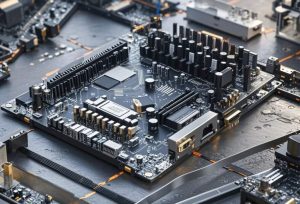目录
ToggleThe industrial motherboard, as the name suggests, is the motherboard installed in the industrial computer chassis. Because the industrial motherboard needs to adapt to some harsh industrial environments, it often has high requirements for its performance. For example, common industrial motherboards need to meet wide temperature requirements and require high-load work without shutting down for a long time.
An industrial control motherboard is a special motherboard mainly used in industrial computers to help handle industrial projects. The industrial motherboard is a card-shaped composite board. Like commercial motherboards, it is filled with various industrial components and covered with various sockets. , From the board type, the industrial motherboard is relatively small, and there are two three, or four PCL ports!

There will also be two or more memory sockets, and the industrial motherboard uses a low-power chip to save energy consumption and problems such as high temperature during long-term operation. Moisture and high-temperature resistance, a strong ability to adapt to the environment, so when you use it, you must distinguish between commercial motherboards and industrial motherboards!
Design features of industrial motherboards:
Components: The components of industrial motherboards are different from ordinary commercial motherboards. The materials used for industrial motherboards need to consider the needs of industrial occasions such as high-temperature resistance and moisture resistance. However, ordinary commercial motherboard materials pursue high-cost performance.
Interface design: Due to the special use of the industrial motherboard, the design of the industrial motherboard interface will be customized or stacked with many standard interfaces to adapt to various interfaces. For example, some industrial motherboards have multiple network ports. The industrial computer using this motherboard is called a multi-network port industrial computer, which can be used in firewalls, vulnerability scanning, one-way gatekeepers, industrial gateways, intrusion detection, Internet behavior management, data encryption, information exchange, and centralized monitoring platforms. Help users protect data security and prevent malicious intrusion from destroying data. It is one of the first choices for protecting data security.
Protection function: The industrial motherboard is specially designed to automatically restart the watchdog when encountering abnormal situations such as industrial computer crashes, to ensure the high stability of the system in harsh environments. To save costs, the general commercial motherboard will not be equipped with a watchdog.
The industrial motherboard’s working environment is relatively harsh. To meet the conditions of industrial use, some parameters of the industrial motherboards need to meet industrial-grade requirements, and the working temperature of the industrial motherboards needs to be able to work between -30 to +80 degrees. The working humidity range of the industrial motherboard can reach non-condensing 0~95%. The industrial motherboard’s requirement for environmental dust is that it can contain metal dust and continue to work in an environment of ordinary dust.
At the same time, the industrial motherboard can work in a strong electromagnetic interference environment, and its radiation control ability is strong. Most industrial computers work for a long time, so this requires the industrial motherboard to be permanently turned on. These requirements are not met by ordinary commercial motherboards, which is the advantage of industrial motherboards.
The difference between an industrial control mainboard and an ordinary mainboard:
1.) In terms of function, an industrial motherboard is generally for the specific needs and specific functions of customers, while the ordinary main board is a public demand and has more functions.
2.) In terms of stability, an industrial motherboard emphasizes ultra-stable, trouble-free, uninterrupted operation without failure; ordinary motherboards have dazzling functions, cool performance, and how long they can run for a long time. This is not guaranteed by ordinary commercial motherboards. of.
3.) There are also differences in the heat dissipation scheme. The industrial motherboard pays attention to heat dissipation efficiency, while the ordinary motherboard focuses on the appearance design.
4.) Industrial motherboards are generally based on specific needs, and most of them are customized according to customer requirements, so the number is small and the price is relatively expensive. However, ordinary motherboards are not. They are very cheap, in great demand, and popular.
5.) The workmanship and materials are different. The industrial motherboard is generally used in a very harsh environment. The design requires anti-interference. The materials used can support a wide temperature range to ensure stable operation for a long time; ordinary motherboards are used at room temperature. The quantity and quality of materials used are not as strict as the industrial control motherboard.
6.) The life cycle is different. Industrial motherboards are often used in medical equipment, data monitoring, manufacturing, education equipment, and other occasions. These occasions require equipment to operate stably for a long time and also require long-term stable supply. Some industrial control motherboards have a life cycle of ten years. For a few years, ordinary motherboards have often been updated and iterative to meet the needs of the public, and new products are launched almost every year.
0